
The ZX Spectrum is an 8-bit home computer developed and marketed by Sinclair Research. Considered one of the most influential computers ever made, it is also one of the best-selling British computers ever, with over five million units sold. It was released in the United Kingdom on 23 April 1982, and around the world in the following years, most notably in Europe, the United States, and Eastern Bloc countries.
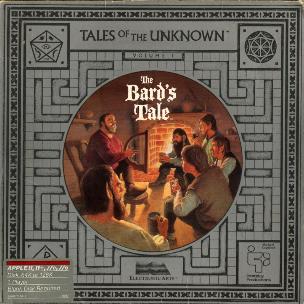
The Bard's Tale is a fantasy role-playing video game designed and programmed by Michael Cranford for the Apple II. It was produced by Interplay Productions in 1985 and distributed by Electronic Arts. The game was ported to the Commodore 64, Apple IIGS, ZX Spectrum, Amstrad CPC, Amiga, Atari ST, MS-DOS, Mac, and NES. It spawned The Bard's Tale series of games and books. The earliest editions of the game used a series title of Tales of the Unknown, but this title was dropped for later ports of The Bard's Tale and subsequent games in the series.

Elite is a space trading video game. It was written and developed by David Braben and Ian Bell and originally published by Acornsoft for the BBC Micro and Acorn Electron computers in September 1984. Elite's open-ended game model, and revolutionary 3D graphics led to it being ported to virtually every contemporary home computer system and earned it a place as a classic and a genre maker in gaming history. The game's title derives from one of the player's goals of raising their combat rating to the exalted heights of "Elite".

Sabre Wulf is an action-adventure game released by British video game developer Ultimate Play the Game for the ZX Spectrum home computer in 1984. The player navigates the pith-helmeted Sabreman through a 2D jungle maze while collecting amulet pieces to bypass the guardian at its exit. The player does not receive explicit guidance on how to play and is left to decipher the game's objectives through trial and error. Sabreman moves between the maze's 256 connected screens by touching the border where one screen ends and another begins. Each screen is filled with colourful flora, enemies that spawn at random, and occasional collectibles.

Level 9 was a British developer of computer software, active between 1981 and 1991. Founded by Mike, Nicholas and Pete Austin, the company produced software for the BBC Micro, Nascom, ZX Spectrum, Commodore 64, Oric, Atari 8-bit computers, Lynx 48k, RML 380Z, Amstrad CPC, MSX, Amiga, Apple II, Memotech MTX, and Enterprise platforms and is best known for its successful text adventure games until a general decline in the text adventure market forced their closure in June 1991.
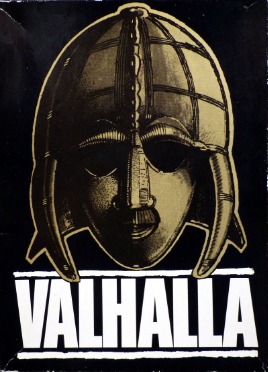
Valhalla is a text adventure with graphics published in 1983 by the British studio Legend for the ZX Spectrum. It reached number one in the UK sales charts. The Commodore 64 version of the game was released in 1984 and reached number five.

3D Monster Maze is a survival horror computer game developed from an idea by J.K. Greye and programmed by Malcolm Evans and released in 1981 for the Sinclair ZX81 platform with the 16 KB memory expansion. The game was initially released by J. K. Greye Software in December 1981 and re-released in 1982 by Evans' own startup, New Generation Software. Rendered using low-resolution character block "graphics", it was one of the first 3D games for a home computer, and one of the first games incorporating typical elements of the genre that would later be termed survival horror.

The Lords of Midnight is an epic fantasy video game combining aspects of wargames and graphic adventures, written by Mike Singleton and originally released in 1984 for the ZX Spectrum. Very well received from the beginning, it was soon converted for the Amstrad CPC and Commodore 64. The game featured an innovative 3-D effect that Singleton called landscaping, which served to bring the player into the game much more than usual. The Lords of Midnight is often named with Elite as among the top role-playing games of the 1980s. The player must destroy Doomdark, the evil Witchking who has locked the Land of Midnight in perpetual winter. There are multiple ways in which this can be achieved. It was followed by Doomdark's Revenge also in 1984, and Lords of Midnight: The Citadel in 1995.

CRL Group plc was a British video game development and publishing company. Originally CRL stood for "Computer Rentals Limited". It was based in King's Yard, London and run by Clem Chambers.
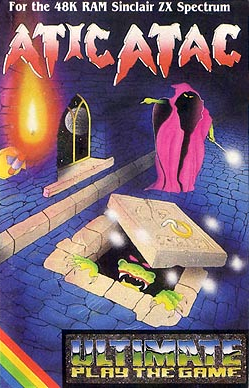
Atic Atac is an arcade-adventure video game developed and published by Ultimate Play the Game, released for the ZX Spectrum in 1983 and the BBC Micro in 1985. The game takes place within a castle in which the player must seek out the "Golden Key of ACG" by unlocking doors and avoiding enemies. It was Ultimate's second game to require 48K of RAM; most of their previous games for the Spectrum ran on unexpanded 16K models.

Eureka! is a video game for the Commodore 64 and ZX Spectrum computers, written by Ian Livingstone, developed by Novotrade for Andromeda Software and published by Domark in 1984.

Star Raiders II is a space combat simulator released in 1986 for Atari 8-bit computers as a sequel to 1979's Star Raiders, which was the killer app for the system. The game was originally developed as part of a tie-in with the movie The Last Starfighter, which featured an arcade game of the same name as part of its plotline. Versions for the Atari 5200 and the Atari 8-bit computers were developed in 1984, although those were never released. Later the tie-in was dropped, and the game converted into a sequel to Star Raiders by changing a number of gameplay elements. The gameplay remained different from the original Star Raiders.
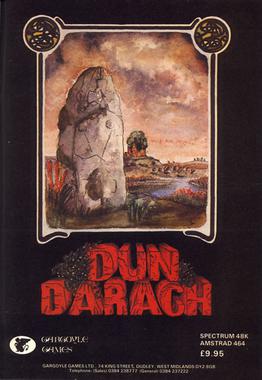
Dun Darach is an arcade adventure developed and published in 1985 by Gargoyle Games for the ZX Spectrum and Amstrad CPC computers. It is a prequel to the 1984 game Tir Na Nog. The plot has Celtic hero Cuchulainn on a search to find his companion Lóeg in the mysterious city of Dun Darach. Inspiration for the game came from the works of Fritz Leiber and Michael Moorcock.

Mike Singleton was a British video game designer who wrote various well-regarded titles for the ZX Spectrum during the 1980s. His titles include The Lords of Midnight, Doomdark's Revenge, Dark Sceptre, War in Middle Earth and Midwinter. Before developing video games, Singleton was an English teacher in Ellesmere Port, Cheshire, England.
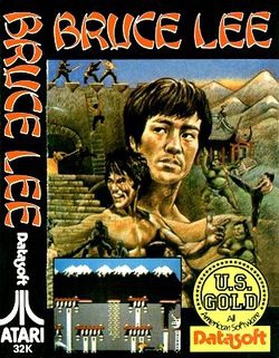
Bruce Lee is a platform game written by Ron J. Fortier for Atari 8-bit computers and published in 1984 by Datasoft. The graphics are by Kelly Day and music by John A. Fitzpatrick. The player takes the role of Bruce Lee, while a second player controls either Yamo or alternates with player one for control of Bruce Lee.
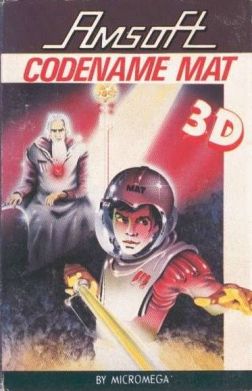
Codename MAT is a space combat simulator published in 1984 by Micromega for the ZX Spectrum and Amstrad CPC written by Derek Brewster. The game is similar to Atari, Inc.'s Star Raiders from 1979. Both games allow switching between front and aft-facing views and have strategic chart and scan modes. While Star Raiders has the player fighting Zylons, in Codename MAT the enemies are Myons.

The Dukes of Hazzard is a 1984 racing video game developed and published by Coleco for their ColecoVision game console and Coleco Adam computer. Elite Systems released a different game with the same title for the ZX Spectrum computer on February 23, 1985. Both versions are based on the television series of the same name.

Football Manager is the first game in the Football Manager series.
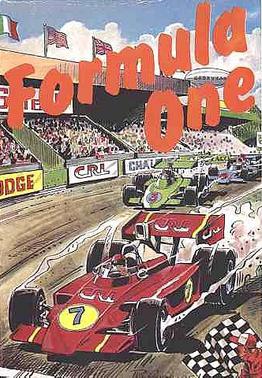
Formula One is a Formula One racing management video game published in 1985 by CRL Group PLC. It was developed by G.B. Munday and B.P. Wheelhouse for the ZX Spectrum, and converted to Amstrad CPC by Richard Taylor.

Ace is a combat flight simulator video game published for the Commodore 64, VIC-20, and Plus/4 in 1985 by Cascade Games. It was ported to the Amstrad CPC, Amstrad PCW, Amiga, and ZX Spectrum.




















